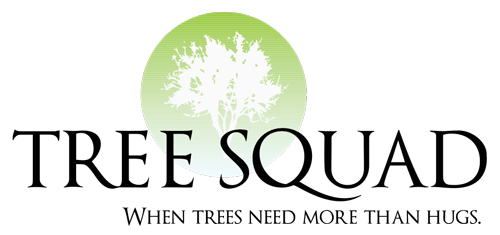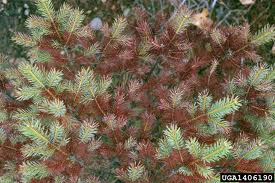Rhizosphaera Needle Cast
Attacks:
Colorado spruce, white and black hills spruce
What you will see:
Thin trees with lower branch dieback
- Excessive thinning/ dropping of older needles
- Black dots in the stomata on the underside of the needles
- Yellow and purple/brown needles
Life cycle:
- Needles are infected with the pathogen in spring during wet weather
- New needles are susceptible to disease - all year long
- Fallen needles produce spores that re-infect healthy needles
- Wet and/or humid conditions promote disease
Cultural practices:
- Reduce moisture adjacent to tree
- Move sprinkler heads
- Do not water foliage
- Increase air flow through canopy
- Prune out infected tissue
- Remove fallen needles
- Do not plant Colorado spruce
Chemical Treatments:
- Treat foliage with fungicide to prevent infection
- Make sure treated trees will not continue to be in contact with moisture
- After treatment needles may continue to change color and fall off, since infection occurred prior to treatment.
Additional Rhizosphaeara Needle Cast Information:
When it comes to fungal diseases in your trees, Rhizosphaeara needle case it one of the most common. It can affect spruces, white pines, firs, and even hemlock. It’s important to get a sense of what it looks like and what causes it so you can get a better sense of how to deal with it. Here’s what you need to know about Rhizosphaera needle cast.
If you start to notice thinning of the inner needles of the lower branches of your spruces, it may be a sign. Younger needles generally stay healthy, but the older ones shed. With a magnifying glass, you should see small black dots on those shed needles. The black dots are the fungus, and are how Rhizosphaera needle cast is diagnosed.
Rhyzosphaera kalkhoffii, a fungus, causes Rhizosphaera needle cast. As needles get infected, whether they are still attached to the tree or have already been shed, they release spores. These spores get blown by the wind or fall onto other branches and in turn infect those needles.
There are fungicides available that have chlorothalonil or copper that can help treat infected trees. Unfortunately, if a tree is already infected, it won’t cure that infection, but it will help prevent further damage. The treatment should be used every three to four weeks, and works best when the weather is wet. It’s important not to use the same fungicide in consecutive treatments. Alternate the copper and chlorothalonil to prevent fungicide resistance. It can be hard, but when you’re treating a tree, make sure to cover the tree entirely. Make sure to also read all the warnings and instructions on the label for the fungicides that you use.
The simplest way to prevent Rhizosphaeara needle cast is to not plant Colorado blue spruce. It’s the most susceptible to the disease, and can infect the trees around it. If you are planting trees, make sure you have good spacing between them. The better the airflow means the needles will dry faster, which helps prevent infection from taking hold.
Knowing everything you can about Rhizosphaeara will help you not only treat it, but also prevent it in the future.


